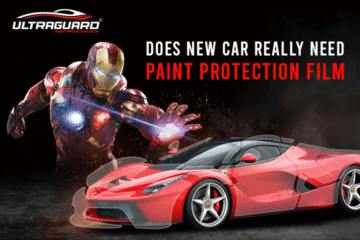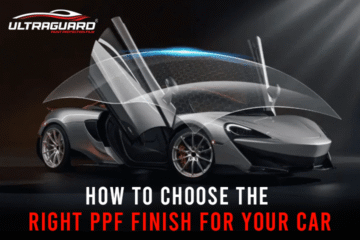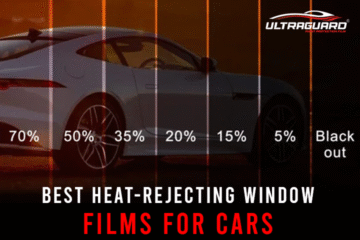The paintwork of your car is not just a color; it’s a statement and reflection of your overall care. But ask any car lover and they’ll tell and admit that the biggest enemy of he automobile’s paint is the water spots. These hideous mineral deposits that remain after the quick wash, rain, or sprinkle can etch themselves into your clear-coated car, ending up dulling the finish and becoming hard to remove.
Sealants and waxes were the traditional solution for this problem for years, providing a short-term barrier. But the automobile industry has witnessed a ground-breaking invention that provides unmatched, long-term protection- Presenting Paint Protection Film (PPF). This transparent, self-healing film is rapidly becoming the ultimate protection against not only scratches and chips, but also slight damage from water spots.
In this exhaustive handbook, we will take you deep into the universe of Paint Protection Film, identifying its numerous advantages, specifically highlighting how it is the ace when it comes to protecting against water spot damage. We will examine why PPF coating is a revolution for keeping your car’s showroom finish intact and how this investment can save your time, energy, and money in the long term.

The Problem That Refuses to Wash Away: More Than a Nuisance
Let’s discuss the enemy first before we sing the praises of Paint Protection Film. Water spots are what most car owners mistakenly think they are: cosmetic blemishes that can simply be wiped off with a detailer. Sadly, not usually so, particularly when using hard water.
Pure water is not pure; it contains dissolved minerals like calcium, magnesium, and bicarbonates. When water flies off (evaporates) your car’s surface, the minerals and deposits are left behind. As the sun shines, these mineral deposits actually “bake” onto the clear coat. In time, they can rust and etch into the fragile surface, creating a lasting imperfection.
There are two kinds of water spots
Type 1 (Hard Water Spots)
These occur most frequently and result from mineral deposits. They manifest as white, cloudy rings on the paint. Initially superficial, if not treated, they will bond extremely well with the clear coat.
Much worse are Type 2 (Etched Water Spots/Acid Rain Etching)
These occur when corrosive water—like acid rain or mineral-rich water that has come into contact with airborne pollutants—evaporates onto paint. Without expert paint correction, which involves sanding and polishing off layers of clear coat, these blemishes tend to be irreparable because they digest the clear coat and create pits or depressions.
The most important point here is that prevention is much simpler and more effective than a cure. Once etching happens, the only solution to repair it is to remove the spoiled clear coat, which weakens the protective cover on your car and can affect its long-term integrity and look.
The Primary Benefit: Paint Protection Film’s Role in Battling Water Spots
Now, let’s get to the topic, ‘How Paint Protection Film benefits specifically in handling water spot damage. This is where PPF outdoes, providing better protection than standard waxes and sealants simply cannot compete with.
1. Enhanced Hydrophobicity: Beading and Sheeting Action
The most important Paint Protection Film benefit against water spots is its increased hydrophobic nature. Although the new wax or sealant will make water bead at first, all too often this soon wears off, particularly after a couple of washes or after some rough weather.
High-quality Paint Protection Film, especially those with a built-in top coat, provides a permanent and superior hydrophobic surface. This indicates water droplets condense into tight, spherical beads with little contact with the surface of the film. These beads are subsequently much more likely to roll off the car because of gravity or airflow during driving, instead of standing and evaporating.
Even if there is water that stays behind, the tight beading greatly minimizes the surface area for mineral deposition to occur. On the other hand, on an unprotected or inadequately protected surface, water will “sheet” and spread out in a thin film covering a vast area, resulting in widespread water spotting as it evaporates. The persistent beading action by the PPF coating is a very strong first line of defense.
2. Physical Barrier Against Etching
This is likely caused by the most important Paint Protection Film benefit mentioned regarding etched water spots. As explained, once acid rain or hard water etches into your clear coat, it’s a permanent physical distortion. Paint Protection Film can serve as a strong, sacrificial barrier.
When mineral- or acid-based water dries on your car, it is not your factory paint that receives the brunt of the assault, but rather your PPF. The minerals will settle on the surface of the film. Although they may continue to leave blemishes on the film, these are on the film and not your clear coat.
Imagine:
When you unknowingly spill a corrosive substance on your phone’s screen, you want it to land on the screen guard instead of the screen itself. That’s what Paint Protection Film does for the paint of your vehicle; it works as a screen guard. Even when the water spots are refractory on the PPF, they are far simpler to take off from the surface of the film than from the etched clear coat.
In the worst-case situation of aggressive, irreversible etching on the PPF, the film can be safely removed and replaced, and your original paint is in perfect condition. This is a huge benefit compared to repainting a panel owing to irreversible etching.
3. Ease of Cleaning and Maintenance
Another important Paint Protection Film benefit is that it makes car washing and maintenance easier, consequently avoiding water spots. Because of its smooth, non-absorbing surface and hydrophobic properties, dust, dirt, and atmospheric contaminants (such as mineral deposits) adhere loosely to the film.
Water spots, while they do happen, are typically much less tacky and can be easily wiped away with less effort and milder chemicals than it would require to remove them from a bare clear coat. This reduces the need for hard scrubbing or abrasive cleaners, again safeguarding your paint.
Many PPF applications carry ceramic coatings over the Paint Protection Film to double down on the hydrophobic nature and make the surface slicker and easier to clean. This two-layer protection makes the surface virtually impenetrable to contaminants and easy to clean, preventing water spot formation.
4. Self-Healing Properties and Minor Swirl Prevention
Although not specifically water-spot-related, the self-healing property of Paint Protection Film helps indirectly in keeping a surface as clean and water-spot-free as possible. Water spots become more apparent and collect more easily on a surface already pockmarked with swirl marks and micro-scratches. Such blemishes form microscopic valleys and peaks where water has a tendency to congregate and minerals tend to settle.
The self-healing nature of the PPF coating means that the surface is extremely smooth. Light swirls produced by washing or light scratches disappear when they are heated, and the surface remains perfectly flat. The smoother, flatter surface beads water and drains off more effectively, reducing water areas where water can pool and evaporate. This consistency of surface integrity is an underlying but highly effective factor in preventing water spotting and making it simple to remove when they do occur.
Concluding with – The Future of Automotive Paint Protection
Water spots, all innocent-looking marks, can quickly become a minor annoyance and eventually turn into a long-term headache for your car’s paint. While routine washing and traditional protection practices bring some comfort, they cannot even come close to offering the full, complete protection that Paint Protection Film does. And Ultraguard has one of the best brands to provide PPFs with every possible feature, from self-healing to colored PPFs, it has all of them.
From its great hydrophobic nature that causes water to bead and roll off, to its strong physical barrier against etching, and its simplification of cleaning and preserving a clean surface, the Paint Protection Film’s benefits in fighting water spot damage are impossible to deny.
Having a PPF coating put on your vehicle is not only a protective option; it’s an investment in keeping it preserved. It translates to less time fighting against pesky water spots, less anxiety about road debris, and more time soaking in the perfect, factory-new look of your beloved vehicle. In the automotive world, Paint Protection Film is the silent hero, guarding your car’s paint to remain brightly shining for years to come, free from the nagging menace of water spot horrors.
Frequently Asked Questions (FAQs)
Q1: Can water spots be entirely removed in the presence of Paint Protection Film?
No product can promise 100% elimination, but Paint Protection Film dramatically decreases the occurrence and intensity of water spots.
Q2: Will water spots ruin my PPF forever?
Mostly not. Although very hard water does have the ability to leave a visible mineral deposit on the film, these are usually surface-level and can usually be removed using specially made water spot removers for PPF, or even mild acidic cleaning agents (first test in an inconspicuous area, or talk to your installer).
Q3: How do I get rid of water spots on my PPF?
All that should be required for light water spots is a thorough cleaning with a pH-balanced car shampoo and quick drying. For tough areas, contact a professional detailer or your PPF installer.
Q4: If my car has Paint Protection Film, do I still need to give it a regular wash?
Indeed! Maintaining the longevity and aesthetic appeal of your PPF coating requires routine film washing.
Q5: Is it possible to apply a ceramic coating over Paint Protection Film?
Absolutely, and strongly recommended! The hydrophobic effect can be enhanced by applying a ceramic coating made especially for PPF.
Q6: Can Paint Protection Film damage paint?
No, paint protection film is meant to protect your car’s factory paint from the everyday road rock chips, grime, swirl marks, minor scratches, etc.




0 Comments